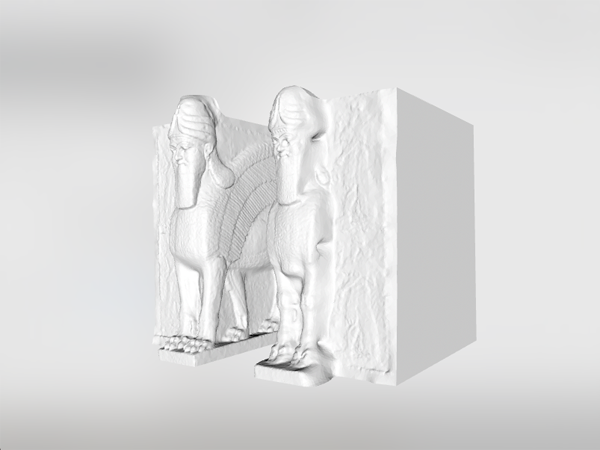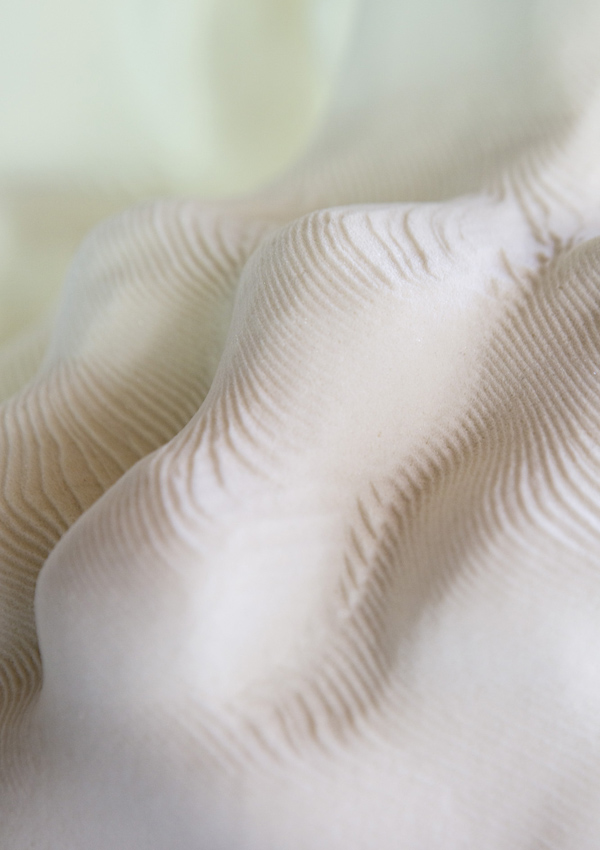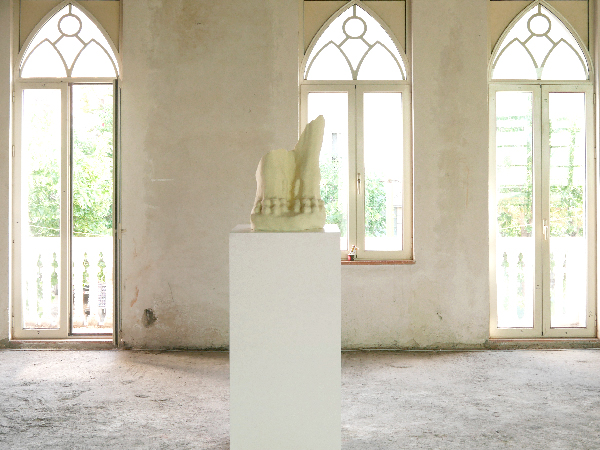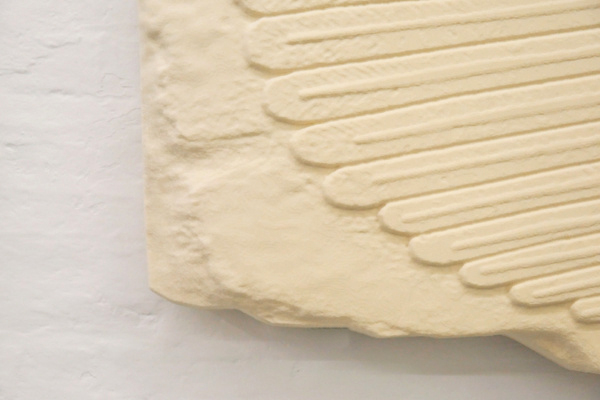Lamassu (With Love and Embers) CNC sculpture, high-density foam Paws/zampe
44 x 68 x 36 cm
Wing/ala
113 x 100 x 12 cm
2017 / 2019
Head/testa
60x32x40 cm
2024
Relaized with the contribution of Mediterranean Landscapes / La Ville Ouverte, for Mediterranea 18, Young Artist Biennale, Tirana 2017
EN
The work, produced with a numerical control machine (CNC) for 3D modeling, relates to two fragments of Lamassu. This anthropomorphic statue from the Assyrian age was a common figure in the territory of Ancient Mesopotamia, found on the gates of cities and buildings. The work is based on a digital rendering of fragments drawn from a 3D-scan of the whole statue. This 3D image was realized as part of the project Virtual Museum of Iraq, a multimedia archive created between 2005 and 2009. The project involved the digitalization and scanning of several artifacts from the Iraqi region. It was financed by the Italian Ministry of Foreign Affairs and produced in the National Research Council laboratories (CNR) with the aim of protecting and promoting the archaeological and artistic heritage of that region.
The work, produced with a numerical control machine (CNC) for 3D modeling, relates to two fragments of Lamassu. This anthropomorphic statue from the Assyrian age was a common figure in the territory of Ancient Mesopotamia, found on the gates of cities and buildings. The work is based on a digital rendering of fragments drawn from a 3D-scan of the whole statue. This 3D image was realized as part of the project Virtual Museum of Iraq, a multimedia archive created between 2005 and 2009. The project involved the digitalization and scanning of several artifacts from the Iraqi region. It was financed by the Italian Ministry of Foreign Affairs and produced in the National Research Council laboratories (CNR) with the aim of protecting and promoting the archaeological and artistic heritage of that region.
The two sculptures result from merging the 3D scan of the Nimrud Lamassu with the photographs released by the French news agency (AFP) on November 15, 2016. The photos document what remains of the Lamassu after its destruction carried out by militants of the Islamic State (ISIS).
In 2024, on the occasion of the solo exhibition "With Love and Embers" at the Barvinskyi Gallery in Vienna, a third element was added to the series. The original fragment related to the head was detached from the body of a Lamassu at the archaeological site of Khorsabad (Iraq) in 1995 by a group of Iraqi looters who attempted to export it illegally to sell it on the black market. Recovered by the authorities and restored, the original is now on display at the Iraq Museum in Baghdad, with the cuts from the dismemberment still visible.
The reconstruction of this last element was made possible thanks to the collaboration of the University of Baghdad.
For more information, please refer to the exhibition text written by Rosaura Cauchi:“Echoes of Catastrophe: Ryts Monet's Exploration of Resilience and Ruin”.
IT
Nel 2024, in occasione della mostra personale “With Love and Embers” presso la Barvinskyi Gallery di Vienna, è stato aggiunto un terzo elemento alla serie. Il frammento originale relativo alla testa fu staccato dal corpo di un Lamassu nel sito archeologico di Khorsabad (Iraq) nel 1995, da un gruppo di saccheggiatori iracheni che tentarono di esportarlo illegalmente per rivenderlo sul mercato nero. Recuperato dalle autorità e restaurato, l'originale è ora esposto all'Iraq Museum di Baghdad, con i tagli dovuti allo smembramento ancora visibili.
L’opera è stata realizzata con una macchina a controllo numerico (CNC) per la prototipazione di modelli 3D ed é relativa a due frammenti di Lamassu, un'imponente scultura antropomorfa in pietra di epoca assira, diffusa sul territorio della mesopotamia antica con la funzione di sorvegliare gli ingressi delle città e dei palazzi. Il file utilizzato è il risultato di una scansione 3D realizzata a Nimrud (Iraq) tra il 2005 e il 2009 per il Virtual Museum of Iraq, un archivio on-line che raccoglie le principali opere e reperti presenti sul territorio iracheno. L’archivio multimediale è stato finanziato dal Ministero degli Affari Esteri italiano e realizzato nei laboratori del Consiglio Nazionale delle Ricerche con l’obiettivo di salvaguardare e diffondere il patrimonio archeologico ed artistico iracheno.
Le due sculture
sono il risultato dell'incrocio della scansione 3D del Lamassu di
Nimrud con le fotografie rilasciate dall'agenzia di stampa francese
(AFP) il 15 novembre 2016. Le immagini documentano ciò che resta del
Lamassu in seguito alla sua distruzione avvenuta ad opera dei
miliziani dello Stato Islamico (ISIS).
Nel 2024, in occasione della mostra personale “With Love and Embers” presso la Barvinskyi Gallery di Vienna, è stato aggiunto un terzo elemento alla serie. Il frammento originale relativo alla testa fu staccato dal corpo di un Lamassu nel sito archeologico di Khorsabad (Iraq) nel 1995, da un gruppo di saccheggiatori iracheni che tentarono di esportarlo illegalmente per rivenderlo sul mercato nero. Recuperato dalle autorità e restaurato, l'originale è ora esposto all'Iraq Museum di Baghdad, con i tagli dovuti allo smembramento ancora visibili.
La ricostruzione di quest’ultimo elemento é stato reso possible grazie alla collaborazione dell’Università di Baghdad.
Per ulteriori informazioni, consultare il testo della mostra scritto da Rosaura Cauchi: “Echoes of Catastrophe: Ryts Monet's Exploration of Resilience and Ruin”.


Fragment of Lamassu after its destruction, Nimrud, November 15th, 2016.
Photo credit: Safin Hamed, AFP, Getty Images

3D scan of Lamassu at Nimrud, realised for the Virtual Museum of Iraq.

Extraction and reconstruction of the 3D model



Ryts Monet, Lamassu (With Love and Embers) (paws), 44 x 68 x 36 cm, 2017.

Installation view at Mediterranea 18, Young Artists Biennale
Former Embassy of Yugoslavia, Tirana, Albania, 2017.
Photo credit: Fabrizio Vatieri


Ryts Monet, Lamassu (With Love and Embers) (wing), 113 x 100 x 12 cm, 2017,
installation view at La caduta degli Dei, Galleria Michela Rizzo, Venezia, 2019.


Ryts Monet, Lamassu (With Love and Embers) (wing and paws),
installation views at Barvinskyi Art Gallery, Vienna, 2024.




Ryts Monet, Lamassu (With Love and Embers) (head), installation views at Barvinskyi Art Gallery, Vienna, 2024.

Head of the Lamassu of Khorsabad (original), Iraq.
Circa 710 B.C. Displayed in the Assyrian Gallery of the Iraq Museum in Baghdad, Iraq.
